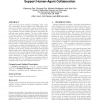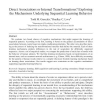231 search results - page 29 / 47 » Cognitive Architecture for Mutual Modelling |
LREC
2010
13 years 9 months ago
2010
Natural language understanding systems require a knowledge base provided with conceptual representations reflecting the structure of human beings' cognitive system. Although ...
ATAL
2005
Springer
14 years 1 months ago
2005
Springer
There has been much research investigating team cognition, naturalistic decision making, and collaborative technology as it relates to real world, complex domains of practice. How...
SIGMOD
2001
ACM
14 years 7 months ago
2001
ACM
From the standpoint of satisfying human's informationneeds, the current digital library (DL) systems suffer from the following two shortcomings: (i) inadequate high-level cog...
IFM
2004
Springer
14 years 1 months ago
2004
Springer
Abstract. Interactive systems combine a human operator with a computer. Either may be a source of error. The veri cation processes used must ensure both the correctness of the comp...
COGSCI
2010
13 years 7 months ago
2010
We evaluate two broad classes of cognitive mechanisms that might support the learning of sequential patterns. According to the first, learning is based on the gradual accumulation...


